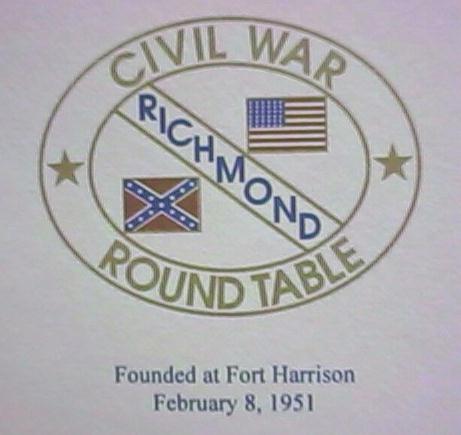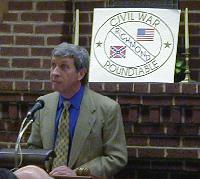


January 2003
rcwrt.org
Brag Bowling, President Art Bergeron, Editor 3019 Kensington Ave 3901 Paces Ferry Road Richmond, VA 23221 Chester, VA 23831-1239
January 2003 PROGRAM Dr. Nelson D. Lankford "Richmond Burning" 8:00 p.m., Tuesday, January 14, 2003, at the Boulevard United Methodist Church, 321 N. Boulevard, Richmond, VA (corner of Boulevard and Stuart Ave.) Enter the basement door on the right side under the front steps. Dr. Nelson D. Lankford is a native of Hampton, Virginia. He received his undergraduate degree from the University of Richmond and his Ph.D. and MBA from Indiana University, Bloomington. For the past eighteen years Nelson D. Lankford has been the editor of the Virginia Magazine of History and Biography, the quarterly journal of the Virginia Historical Society. He is also director of publications and scholarship at the VHS. With Charles F. Bryan, Jr., Lankford is co-editor of Eye of the Storm, which features the memoir, maps, and water colors of Private Robert Knox Sneden. It won the Founders Award of the Museum of the Confederacy. Lankford, Bryan, and James C. Kelly co-edited a related book, Images from the Storm, which presented 300 of Sneden's water colors with commentary from his memoir. Lankford is the author of a biography of Ambassador David K. E. Bruce, entitled The Last American Aristocrat (1996). Earlier books include OSS Against the Reich (1991) and An Irishman in Dixie (1988). His next book, also to be published by Viking/Penguin, is provisionally entitled Cry Havoc: Civil War Comes to America. This book will examine the last weeks of peace in 1861 between Lincoln's inauguration and the beginning of the war. Lankford lives in Richmond with his wife Judy, who is the president of the fund-raising consulting firm, Lankford & Associates, LLC. He is a member of the vestry of Grace and Holy Trinity Church and a former president of the Conference of Historical Journals. Lankford's most recent book is an account of the end of the Civil War in Virginia's capital city. It is called Richmond Burning: The Last Days of the Confederate Capital, published by Viking in August. A paperback edition will be published by Penguin in 2003. His presentation will be based upon this book.
Review of the December Program
 |
Announcements
Membership Renewals Sandy Parker will be sending out membership bills at the beginning of January for payment by February 28. Watch your mailbox for your bill, and please send your dues to Sandy promptly.
Round Table Positions Open Anyone interested in serving as Second Vice President (Tour Chairman) for 2003 or in nominating someone for that position should make their views known at the January meeting. There will be an election at that time. A person (or persons) is needed to handle the snacks provided at the end of each meeting. If you wish to participate in this important endeavor, please see Richard Grosse on January 14.
Museum of the Confederacy Programs Lee-Jackson Day, January 17. Join the Museum at its honors Robert E. Lee and Stonewall Jackson on this state holiday. Enjoy free admission to the Museum all day. Regular admission will be charged for tours of the White House of the Confederacy. Children's Activity Day: Winter Quarters, January 18. Ever wonder how soldiers made it through those chilly winter months outside or what they did in their camps to pass the time? Kids and their parents are welcome to come by the Education room anytime between 1:00 and 4:00 p.m. Children can make crafts related to the period and can speak to two costumed historians who will portray Confederate soldiers. The program is free with museum admission. Research Your Confederate Ancestors Workshop, January 19 and 20. Join the Museum library staff for an introduction of sources and techniques to identify and locate Confederate ancestors and trace their wartime experiences. This special program will run from 2:00 to 4:00 p.m. each day. Admission is free to Museum members and is $15 for the public. Space is limited, so call in to reserve your seat as soon as possible. Phone (804) 649-1861 extension 28.
Civil War Seminars, Symposia, and Tours The Civil War Education Association (CWEA) of Winchester has announced its 2003 calendar of events. It includes more than thirty different programs. They include a field tour of Stonewall Jackson's Winter Campaign of 1862; walking tours of Gettysburg, Spotsylvania, Antietam, and sites in the Richmond area; and the 11th Annual Civil War Symposium (January 29-February 1). Full details are available on the CWEA Web site www.cwea.net or by calling (800) 298-1861. If you wish to write for a copy of the calendar the address is Civil War Education Association, Box 78, Winchester, VA 22604.
RCWRT Monthly Speakers for 2003
Newsletter Deadlines To facilitate the printing and timely distribution of the monthly newsletter, information for it should be submitted to the editors no later than the following dates: For the February newsletter, no later than January 24 For the March newsletter, no later than February 21 For the April newsletter, nolater than March 21 For the May newsletter, nolater than April 25 For the June newsletter, nolater than May 23 For the July newsletter, nolater than June 20 For the August newsletter, nolater than July 25 For the September newsletter, nolater than August 22 For the October newsletter, nolater than September 26 For the November newsletter, nolater than October 24 For the December newsletter, nolater than November 21
Richmond Civil War Round Table Newsletter Art & Carol Bergeron, Editors 3901 Paces Ferry Road Chester, VA 23831-1239
Return to News Letters Index
Return to main page

©R.C.W.R.T. 2003